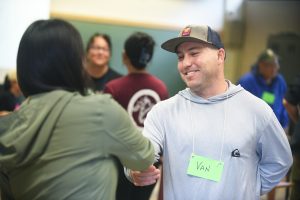Although the last day of any experience is often bittersweet, our potluck dessert table made…
Daily Manaʻo for Cohort Kumukahi March 2024 – Monday
Monday, March 18, 2024
As our team opened the space of Hālau o Haumea for our inaugural Cohort Kumukahi, we offered “Welina Mānoa” to the ʻili ʻāina of Kānewai, upon which stands Kamakakūokalani. Held by the buildings of our predecessors, our oli was carried by the winds of Mānoa to the stream and loʻi just beyond our line of sight. Manuokū and parakeets alike responded as they passed through the winds that quiver the yellowing lāʻī along the gentle slopes of Waʻahila. Remnant leaves and dust swirled around us as we faced Ka Papa Loʻi ʻo Kānewai. As I stood beside two of my coworkers who are much (much) taller than me, I was inspired to fill my voice into the spatial acoustics of the hālau above us. Because we stood as a team, my shoulders lifted and squared, and the reverberations of our oli within Hālau o Haumea held our team as we opened the space.
Importantly, our hoʻokele Punihei took time to explain the moʻokūʻauhau of the Kamakakūokalani Center for Hawaiian Studies. In honoring the space that hosted us for the first two days, we also honored the kūpuna who built such structures to support us.
The weather this day was a little more cloudy and overcast—some of the cohort members were already peering over to loʻi where the sun was warming the kuāuna latticing and bordering the loʻi kalo. Clearly, our cohort members were eager to engage beyond words and ideas in a traditional sense.
In the classroom spaces, we held our first Pilina Circles of the week. With trained Pilina Circle co-facilitators, we were able took turns sharing stories, deeply listening, and finding connections among our people. Pilina Circles are so amazing because they offer us the time and space to participate in personal storytelling in pairs and as a large group. Pilina is an important concept that does not translate easily into English or western ways of thinking. Pilina engages deep reciprocity and encourages us as people to develop and maintain reciprocal relationships that are nurtured over time.
Because I was invited into a Pilina Circle space, I began to engage with some of the humans participating in the cohort. We shared stories with one another, and the prompts encouraged us to speak about the places we care for and protect. As someone who is heavily shaped by the places in which I spend my time and choose to mālama ʻāina, meeting others for the first time through the ways in which they mālama their own ʻāina and their own places was an experience I treasured. To see the light of someone’s aloha for their ʻāina is a beautiful light to share.

